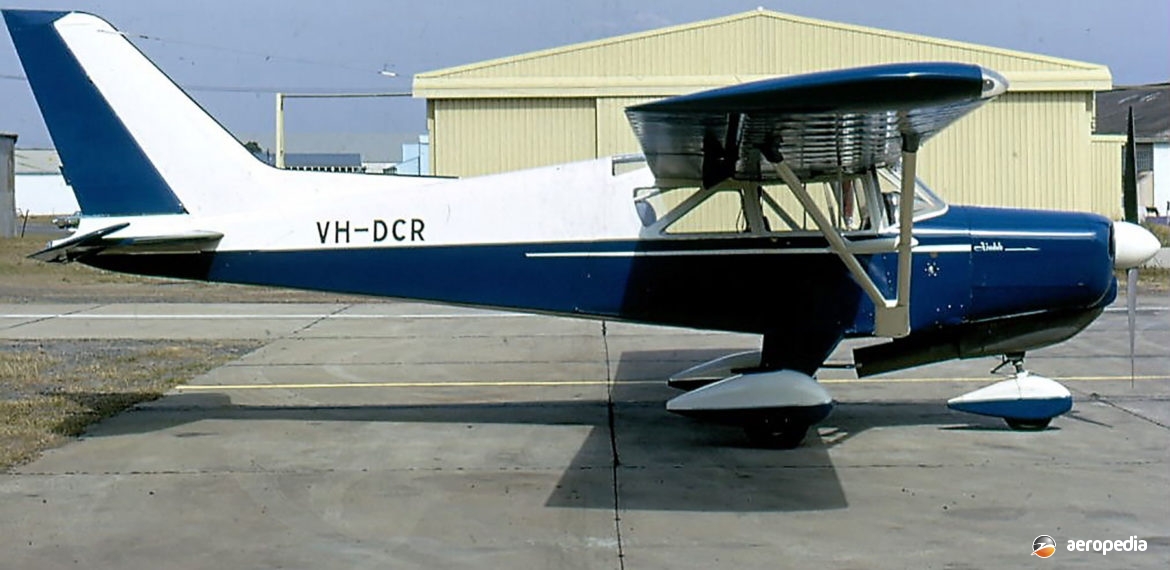Photograph:
Beagle A-109 Airedale VH-DCR (c/n B531) at Bankstown, NSW (David C Eyre)
Country of origin:
United Kingdom
Description:
Four-seat cabin monoplane
Power Plant:
One 134 kw (180 hp) Lycoming O-360-A1A four-cylinder horizontally-opposed air-cooled engine
Specifications:
- Wingspan: 11.08 m (36 ft 4 in)
- Length: 8 m (26 ft 3 in)
- Height: 3.05 m (10 ft)
- Wing area: 10.13 m² (109 sq ft)
- Max speed at sea level: 238 km/h (148 mph)
- Max cruising speed at 1,525 m (5,000 ft): 227 km/h (141 mph)
- Economical cruising speed at 2,285 m (7,500 ft): 217 km/h (135 mph)
- Stalling speed flaps up: 96 km/h (60 mph)
- Stalling speed flaps down: 84 km/h (52 mph)
- Initial rate of climb: 222 m/min (730 ft/min)
- Time to 2,285 m (7,500 ft): 15 mins
- Service ceiling: 3,658 m (12,000 ft)
- Max range with 317 kg (700 lb) payload and 236 litres (52 Imp gals) fuel: 1,690 km (1,050 miles)
- Take-off run on grass: 365 m (1,200 ft)
- Landing run: 183 m (600 ft)
- Empty weight: 740 kg (1,630 lb)
- Loaded weight: 1,202 kg (2,650 lb)
History:
The Beagle A-109 Airedale was designed by the Beagle Aircraft Company to continue the line of light aircraft developed and produced in the United Kingdom by Auster Aircraft. The new aircraft was designed as an interim measure pending the introduction of a new series of all-metal designs, the Company hoping to return to the pre-war British domination of the market in light aircraft. Initial aircraft were modifications of Auster aircraft and the A-109 Airedale was to be the first of the new designs. It was developed from the Auster C.6 Atlantic of 1957 and the Auster D.8, which was never built.
Development of the Airedale proceeded in 1960 and it was fitted with a tricycle undercarriage, a control wheel, a four-seat cabin and a Continental engine. However, by the time production commenced the Cessna 172 Skyhawk series had been in production for some time and, being built in large numbers, was produced at a cheaper price than the Airedale could ever have been produced. By that time also the Piper Cherokee was commencing to enter the market.
The Company used its old method of construction for its new line of aircraft (Terrier, Husky, etc) of welded steel tube fuselage with light alloy and fibreglass covering to the front and fabric covering to the rear. However, a modern American Lycoming O-360-A1A horizontally-opposed air-cooled engine was installed, driving a constant-speed McCauley propeller. The strut-braced wing was an all-metal two-spar structure with metal leading-edge skin, fibreglass wingtips, and fabric covering. In order to help save production costs, the jigs and tooling which had been used on the Auster line of aircraft were also used for the Airedale. Accommodation was provided for four.
The prototype (G-25-11 – later G-ARKE) flew for the first time on 16 April 1961, and this was followed by the first of five pre-production machines on 24 February 1962. The manufacturer calculated it would have to build 567 Airedales before it made a profit. In order to display and fly the aircraft at the Farnborough Airshow in Hampshire it was necessary for the aircraft to be all-British, so the prototype was fitted with a 131 kw (175 hp) Continental GO-300 six-cylinder engine produced under licence by Rolls Royce at Crewe in Cheshire and this model was designated the A.111.
The type did enjoy some degree of success, with examples going to Switzerland and France. One (G-ASBI – c/n B.520) was shipped to Aviation Services Pty Ltd in Adelaide, SA for which it was flown on a demonstration tour by Peter Masefield, son of Charles Masefield, and Lord Trefgarne. Three more were imported by Allied Aviation of Bankstown, NSW.
Further examples were exported and one (G-ARXD), owned by the magazine ‘Flight International’, was flown in the 1963 Kings Cup Air Race and the John Morgan Trophy Race.
Eventually production ceased in 1963 after only 43 aircraft had been produced, said to be due to difficulties in competing with similar size but cheaper American-built aircraft and lack of orders being received.
Six Airedales were imported to Australia in 1962-1963, and all survive. Aircraft registered were: VH-UEH (c/n B526 – ex G-ASCA[ntu]), which was first flown on 6 September 1962 and in the following month was shipped to Australia on board the ‘SS Hector’ together with VH-UEP (c/n B525 – ex G-ASBZ [ntu]) for Aviation Services of Parafield, SA the latter first being registered on 11 January 1963. VH-UEH and VH-UEP arrived on 15 November 1962 and were joined by G-ASBI which operated as a demonstrator, the latter eventually becoming VH-UEM (c/n B520 – ex G-ASBI).
Three more were imported for Allied Aircraft of Bankstown, becoming VH-DCP (c/n B530), first registered on 29 March 1963; VH-DCR (c/n B531) first registered on 11 April 1963, being withdrawn from use on 28 November 1981 and being restored to the register on 22 August 1984; and VH-DCS (c/n B532) first registered on 29 March 1963.
Two Airedales have been registered in New Zealand, one becoming ZK-CCW (c/n B528). This aircraft arrived in New Zealand in 1962 and assembled by the Wellington Aero Club. It first flew on 22 December 1962. In later years it was owned by the East Canterbury Aviation Ltd of Rangitata Island.
A second aircraft became ZK-COA, this being the ex-Australian machine VH-UEP which was withdrawn from service on 15 March 1975 before being exported to New Zealand where it was registered on 28 October 2015, being operated by Maximum Ventures Ltd of Wanaka.

